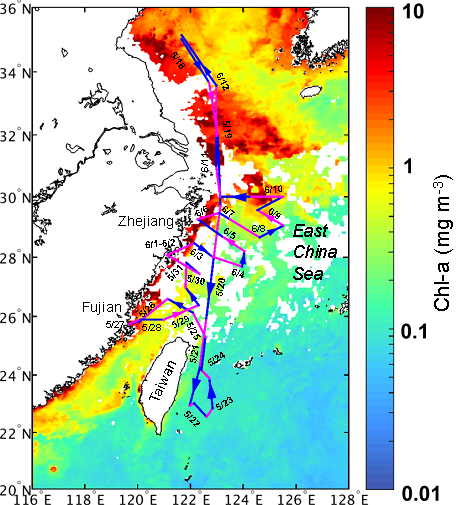Recently, a paper titled “Characterization of biogenic primary and secondary organic aerosols in the marine atmosphere over the East China Sea” from Prof. Pingqing Fu’s research group at the Institute of Surface-Earth System Science, Tianjin University has been published in the international scientific journal Atmospheric Chemistry and Physics (18, 13947-13967, 2018).
Biogenic primary and secondary organic aerosols (BSOA) are important constitutes of atmospheric particulate matter and play a significant role in regional/global air quality and climate change. To date, the knowledge on marine organic aerosols at a molecular level is still rare because of the complexity of their sources and formation mechanism, as well as inconvenience of sampling.

Figure 1. Cruise tracks of KEXUE-1 and spatial distribution of satellite-derived chlorophyll-a concentrations (chl-a, mg m–3) in surface seawater derived from MODIS L3 products during the sampling period in the East China Sea. The purple and blue lines represent daytime and nighttime aerosol samples, respectively.
This paper reported the molecular composition, abundance, spatial distribution and major sources of sugars and BSOA tracers in marine aerosols over the East China Sea (ECS) (Figure 1). Higher levels of target organic species occur to the samples collected near coastal waters and terrestrially-influenced regions, suggesting significant influence of continental aerosols through long-range atmospheric transport. Source apportionment results illustrate that fossil fuel combustion, biogenic SOA formation, biomass burning, and fungal spores were the main sources of OC in marine aerosols over the ECS, highlighting the importance of Asian continent as a major emitter to the coastal marine atmosphere. This work provides useful information for investigating molecular composition and concentration of marine aerosols and help better understand atmospheric chemistry and marine biogeochemical cycling in the western North Pacific Ocean.
The paper link: https://doi.org/10.5194/acp-18-13947-2018